SPAWNING BEHAVIOR - RAINBOW TROUT (part 2)
| Sysadmin Note |
|---|
| Click here for Part 1 |
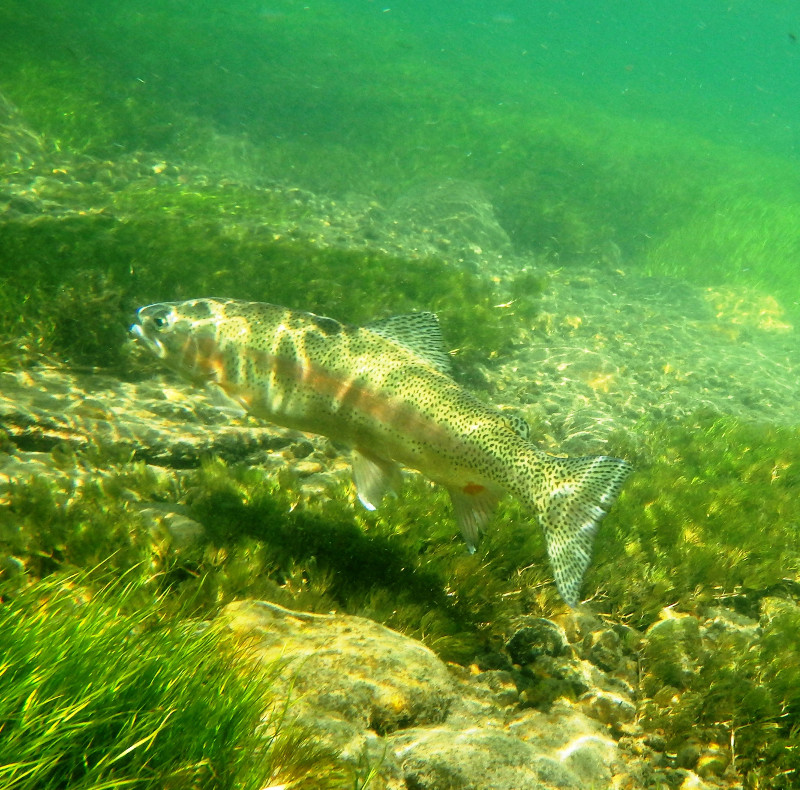
In part one I covered the spawning cycle of the brown trout on the Paradise Valley Spring Creeks. In part two, I will be covering the spawning cycle of the rainbow trout as it relates to the Paradise Valley Spring Creeks. This time-period is often referred to as the Spring Spawning Run however to the anglers who are fishing the weather is often more like late winter.
Once again, the rising water temperature in the Yellowstone River and the increasing length of the day (photo cycle) is what triggers the spring spawning run of rainbow trout. The overall time frame for the rainbow spawning run on the Yellowstone River and the Spring Creeks is March 15th to April 15th. I will note that the spawning cycle can carry on well into May.
However, the general over-all weather cycle can play a definite part in the timing of the spawning run, if we have had an extremely cold the spawning run may on begin until the very end of March. During an extremely warm winter the spawning run can begin in late February, therefore the weather cycle and water temperature can play a part in the timing.
Now this is an important point, the information I am relating only applies to the Yellowstone River outside the boundaries of Yellowstone National Park and the spring creeks of Paradise Valley. Other rivers may have slightly different timing cycles for the rainbow spawning run. Remember the stated cycles are nothing more than guidelines and are not cast in concrete. Nothing in nature is absolute there are always variations, however a check on local conditions on the water you wish to fish will allow you to better plan your trip and be better prepared for the conditions you will encounter.
Now, the rainbow trout go through the same process as the brown trout but there are a few differences between the spawning runs of the two species of trout.
First off, the numbers of rainbow’s entering the spring creek systems to spawn is ten times larger than the number of brown trout which spawn in the system, the brown trout can and will spawn in the main stem of the Yellowstone River. However, rainbow trout are primarily tributary spawner and move to the other streams, creeks and spring creeks which join with the Yellowstone River.
Secondly, even though the brown trout will eat eggs in comparison to rainbow trout it is unbelievable how the rainbow trout are voracious in the appetite for the eggs, in other words they are suckers for the darn things.
Another side note of which the angler needs to be aware of is that the resident rainbow trout of the spring creeks will begin their spawning cycle prior to the entry of the river rainbow’s into the system as water temperature is not a factor for the spring creeks of Paradise Valley as the water temperature is a fairly constant fifty-one degrees.
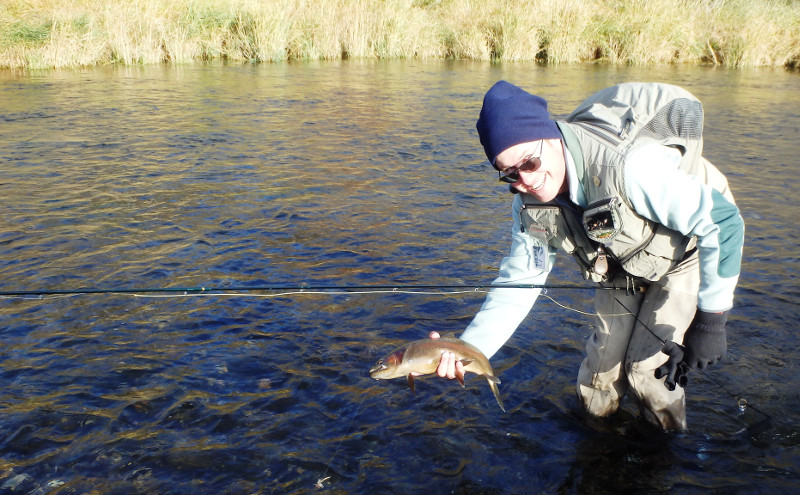
Nice Spring Spawning Rainbow on DePuy’s Spring Creek
As an interesting side-bar, the fly fisher can occasionally catch fall spawning rainbow’s during the brown trout spawning run. The explanation for this occurrence is long and detailed and would take too long the list all the reasons and finding in this selection, it is enough to say that there is a population of fall spawning rainbow trout in the Yellowstone River who find their way into the spring creek system. However, the largest majority of the rainbows do spawn in the spring in the Yellowstone River—Spring Creek systems once again showing that nothing in nature is absolute or set in stone.
During the spring time-period you may also encounter spring Baetis and Midge Hatches, due to the spread of the spawning time-period and the sheer number of trout in the spring creek system during this time-period you can always find Rainbow trout feeding on the hatches as well as the brown trout and occasional cutthroat trout.
During the spring spawning run the fly fishers can find themselves very busy and can partake of all that is offered or select different situations to focus on, it is the choice of the individual angler. For myself personally it depends on the day, but for the purpose of this missive I will be focusing on the spawning rainbow trout.
One again I prefer to stalk and sight fish for the individual rainbows, due to the sheer number of rainbows in the system during this time-period, blind fishing to rainbows who a moving towards their spawning area tends to lead to many foul-hooked trout, which I would rather avoid if possible.
Over the years I have had my share of trout hooked in place besides the mouth and I have witnessed on several occasions with clients I am guiding or other anglers fishing around me, it is something that happens, and it happen to everyone once in a while!
The over-all reaction of most anglers does amuse me, and I have heard some strange remarks over a foul-hooked trout. Some my favorites are; “Oh he doesn’t count as I foul-hooked him”, “You realize that I didn’t mean to do that.” and of course, there is the foul hook-up that isn’t realized until the trout burns off forty feet on line on the first run and breaks the angler off. Now, why do foul-hook-ups happen? There are many reasons this happens, the trout is very fast and aggressive, and the angler was slow to realize the take, or the angler was too fast, or the trout missed the take all together and the angler detected the assumed take and set the hook. There are literally thousands of ways that the trout can get foul-hooked, and all of it is accidently done, to do so deliberately is called snagging and that is another matter entirely!
So, when you do foul-hook a trout try to land it; foul-hooked are generally much more difficult to land because you don’t have them hooked in the mouth and have little control over their actions. However, when I am using streamer or egg imitations I am generally fishing with tippets of 3x or sometimes even 2x, and this allows me to apply greater pressure on the trout and thus land them must faster.
Once again, I prefer to stalk and sight fish for individual rainbows and during the spring of the year this becomes easier to see the trout as the water levels on the spring creeks are at the seasons lowest point as the weed beds have been reduced to winter levels and the water levels maybe as much as eight inches lower than you found them in October.
Many anglers prefer to fish for the spawning rainbows using strike indicators and double nymph rigs and favorite patterns include Egg flies, Red San Juan Worm, Red Bead Midge Worms and Red Copper John’s to name a few and these patterns are very effective and will serve the angler very well indeed.
With the lower water levels this allow me to see and target some of the larger rainbows during the spawning time-period and their fondness for bright flies is also an advantage for the angler, as you can see the trout and see the imitation and adjust your cast accordingly.
In these low water conditions beside catching trout and having fun you have an opportunity to observe the trout, seeing what make it turn away from the imitation or what manipulation causes it to aggressively attack the offering.
Besides the Western Feather Streamer that was listed in part one of this series, which I also use in the spring, I will share with you two different egg fly patterns and another streamer pattern which has been very successful for me.
Most of the time during the rainbow spawning run I am using a single streamer imitation sometimes with an egg imitation in front of the streamer and on rare occasions I will employ a double egg fly rig, and these are the patterns I use.
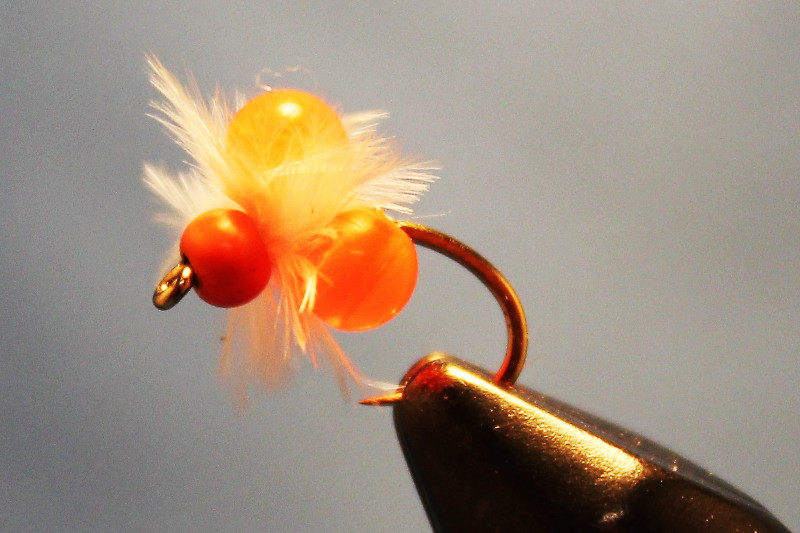
BEAD HEAD 3 EGG CLUSTER
- HOOK: DAI-RIKI #135
- SIZES: 12-16
- THREAD: WHITE 8/0 OR 14/0
- BEADHEAD: SIZE 1/8TH OR 7/64TH ORANGE METAL BEAD
- BODY: THREE PLASTIC 4MM BEADS, STRUNG ON 4X MONO, TIED IN AND WRAPPED, ONE ON EITHER SIDE AND ONE ON THE TOP.
- COLLAR: WHITE AFTER-SHAFT FEATHER, WRAPPED
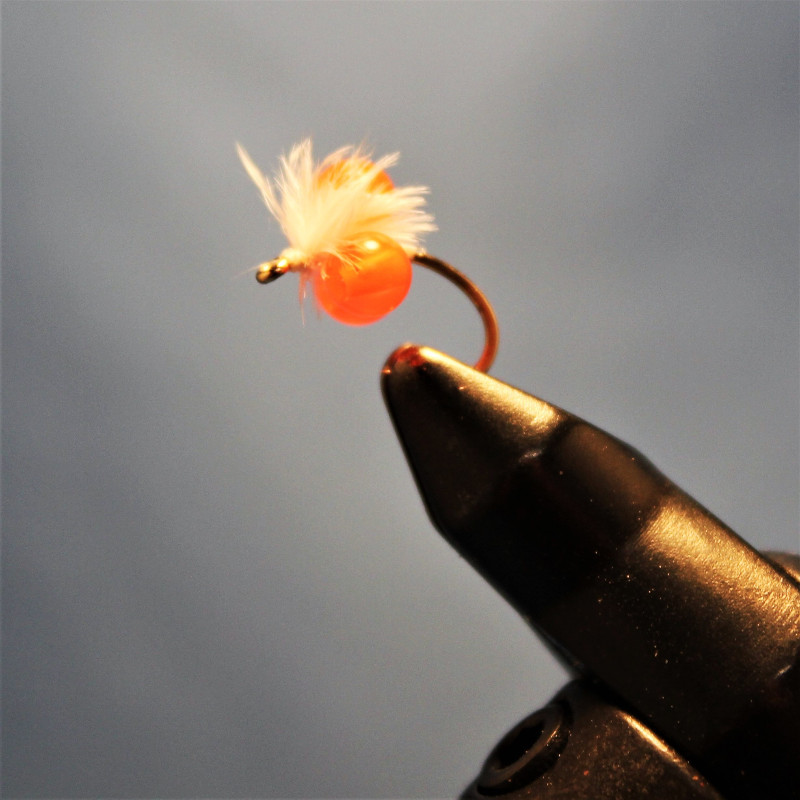
THREE EGG CLUSTER
- HOOK: DAI RIKI #135
- SIZES: 12-16
- THREAD: 8/0 OR 14/0 WHITE
- BODY: THREE 4MM ORANGE PLASTIC BEADS, STRUNG ON 4X MONO
- COLLAR: WHITE AFTER-SHAFT FEATHER OR WHITE HEN HACKLE WRAPPED
MODIFIED LITE SPRUCE STREAMER
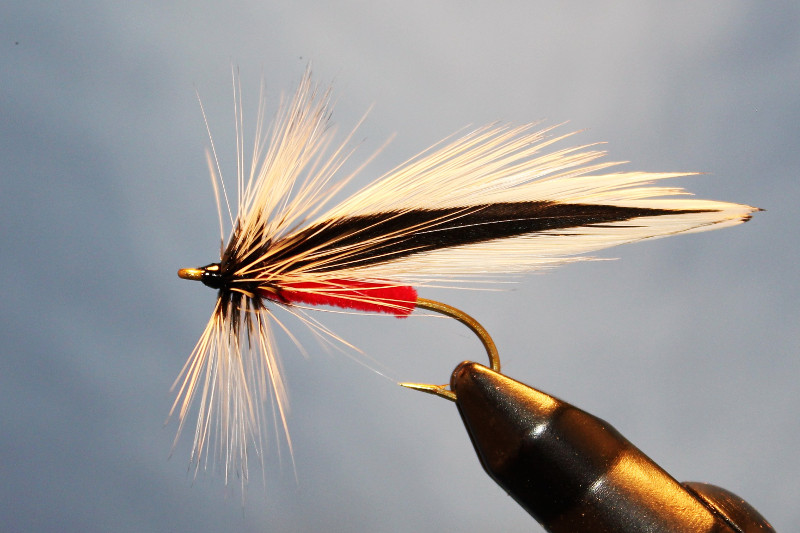
Another of my favorite streamer patterns to use during this time of year is Lite Spruce which I have modified from the original pattern.
- HOOK: TEIMCO 9395
- SIZES: 6-10
- THREAD: 6/0 OR 8/0 BLACK
- BODY: SMALL RED ULTRA CHENNILLE
- WINGS: FOUR, SILVER BADGER HACKLES, TWO PER SIDE, MATCHED WITH THE CONCAVE SIDES PLACED FACE TO FACE, TO EXTEND SLIGHTLY BEYOND THE BEND OF THE HOOK.
- COLLAR: TWO SILVER BADGER HACKLES, WRAPPED
Enjoy & Good Fishin’
Tom Travis, Montana Fly Fishing Outfitter/Guide
